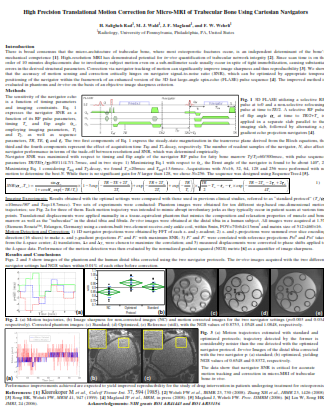High Precision Translational Motion Correction for Micro-MRI of Trabecular Bone Using Cartesian Navigators
Abstract
There is broad consensus that the micro-architecture of trabecular bone, where most osteoporotic fractures occur, is an independent determinant of the bone’s mechanical competence. High-resolution MRI has demonstrated potential for in-vivo quantification of trabecular network integrity. Since scan time is on the order of 10 minutes displacements due to involuntary subject motion even on a sub-millimeter scale usually occur in spite of tight immobilization, causing substantial errors in the derived structural parameters. Correction via navigator tracking of motion can significantly improve image sharpness and thus reproducibility. We show that the accuracy of motion sensing and correction critically hinges on navigator signal-to-noise ratio (SNR), which can be optimized by appropriate temporal positioning of the navigator within the framework of an enhanced version of the 3D fast large-angle spin-echo (FLASE) pulse sequence. The improved method is evaluated in phantoms and in-vivo on the basis of an objective image sharpness criterion.

